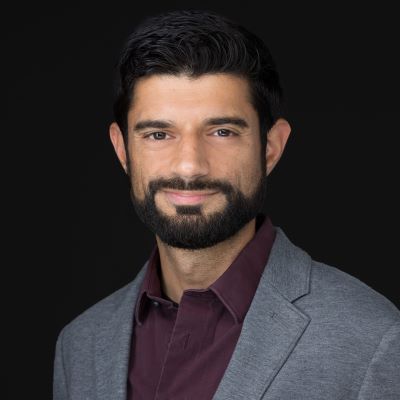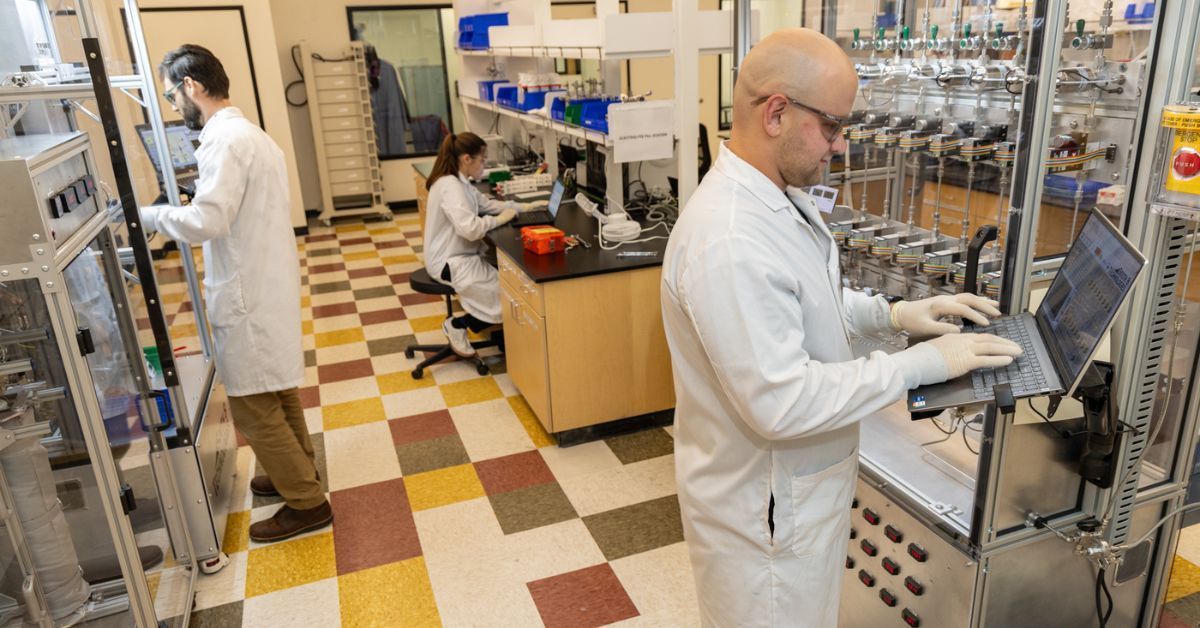A Battery Breakthrough Inspired by a Can of Compressed Air
A UC San Diego engineering alumnus reflects on how a chance curiosity about a can of compressed air, along with support across campus, fueled an innovation in battery technology. The result: South 8 Technologies, a battery company that is solving tough challenges for U.S. private and public sectors.
Published Date
Story by:
Media contact:
Topics covered:
Share This:
Article Content
Breakthroughs can start from simple curiosities. An exciting battery breakthrough at the University of California San Diego, for example, started when a graduate student wondered about those little cans of compressed air that are used for dusting off keyboards. But these kinds of initial ideas have little chance of becoming gamechangers without a university ecosystem that offers support, resources and freedom to explore. Thankfully, with such agency, the compressed-air curiosity turned into a promising new battery technology that could expand battery performance, safety and versatility. Here is a bit of that story. It starts with some battery context.
Our current battery industry needs to be reenergized. The decades-old technology isn’t always the ideal match for some of our recent advancements, like electric vehicles, or for more extreme environments. Fortunately, some companies are charging up potentially ground-breaking ideas.
One such company is the startup South 8 Technologies, a company led and co-founded by alumni from UC San Diego. South 8’s claim to fame is a patented Liquefied Gas Electrolyte (LiGasⓇ) technology, which was named one of TIME’s 200 best inventions of 2024. By replacing the liquid electrolytes in conventional lithium-ion batteries with liquefied gases, South 8 batteries have a world record wide temperature range for their performance: -60 degrees Celsius to +60 degrees Celsius (in comparison, conventional lithium batteries only perform down to 0 or -10 degrees Celsius). Plus, they store more energy per cell and are safer.
Another advantage is the materials needed for these batteries, including the commercially off-the-shelf industrial gases, are all domestically manufactured at high scale today without the need to go abroad, according to Cyrus Rustomji, Chief Science Officer at South 8 and PhD (‘15) alumnus of the UC San Diego Jacobs School of Engineering. Rustomji co-founded South 8 alongside fellow nano engineering alumna Jungwoo Lee.

The initial breakthrough happened during their time at UC San Diego, thanks to the access to equipment and resources, as well as federal funding. South 8 is an example of how advances developed by university researchers are used by the industry to make more powerful, faster and safer devices.
Nowadays the company is getting some attention. For example, because their batteries can power defense applications like radio communication in ultra cold weather regions, the team is landing contracts with the US Army. Car companies are also investing, given the potential these batteries have to improve the electric vehicle market.
While South 8 pushes forward, Rustomji acknowledges all the support for the invention in its earliest years, plus the joy in innovation, in this Q&A. His responses below have been edited for length and clarity.
What is our current status of battery technology? How has it changed recently, and where does it need to go?
The lithium-ion battery was first commercialized over three decades ago. In that time, the chemistry has changed very little. The fundamental chemistry still uses a graphite anode, a metal oxide cathode, and then a liquid-based electrolyte. Now, of course, we've seen energy increase and costs drop. A lot of that is actually due to manufacturing improvements.
This whole revolution was geared towards consumer electronics: cell phone and laptop batteries, that kind of thing. In the past 10 years or so, we've seen this big electric vehicle revolution. What's kind of crazy is now we're trying to pack a lot of these batteries that were commercialized for those smaller applications into larger and larger batteries to drive these big vehicles. That demands a change in the chemistry that we're using.
A lot of people are looking at different types of electrode materials; you see a lot of talk about silicon anodes or sulfur cathodes. There's also a lot of talk about utilizing solid-state electrolytes. There are pros and cons to each of these approaches. Solid-state, for instance, has the promise to deliver higher energy in a safer cell, but it might cost more upfront and take many years until we can get to a larger scale.
So there is a need for a transformative technology, and the jury's still out on what that technology will be. It'll very likely be a multitude of these different technologies for various applications. High-end electric vehicles, low-cost cars might require certain technologies, while aerospace vehicles and drones might require a different type of technology. No one really has that crystal ball today to tell you what that next technology is going to be, other than today’s state of the art will not satisfy tomorrow’s requirements.
You came up with the idea to replace the conventional liquid electrolytes in lithium-ion batteries with liquefied gases while you were a PhD student at the UC San Diego Jacobs School of Engineering. How did your education and experience here support you in discovering this breakthrough in electrolyte chemistry?
First off, UC San Diego has great schools across campus. The engineering school, which I was involved in, is really excellent. Under the guidance of nano engineering professor Shirley Meng, who's a world-renowned expert in battery materials, I received a great education and fundamental understanding of where batteries were and where they needed to go.

The idea for LiGas sparked when I was literally just sitting at my desk one day. You might be familiar with these little compressed air cans that you can dust off your keyboard with. I was looking at that one day and was curious what is in that little can. I turned the can over, and it read “difluoroethane.”
Difluoroethane just happens to be a very unique gas in which you can liquefy under a moderate amount of pressure. It's non-toxic, but it's also polar enough to solubilize salts, which I found very interesting. And being a gas, it doesn't freeze until extremely low temperatures.
So I was thinking to myself, "Could it enable a low-temperature electrolyte, which is liquid inside the cell but it's under pressure, and open up the application space for ultra low-temperature operating cells?" As we continued the exploration here, sure enough, it really did deliver awesome low-temperature performance.
It also came to us over time that we can enable higher safety, energy and power capability for fast-charging vehicles. We're like, "Oh, wow, we can really do something with this." At the end of the day, we decided to do a spin-out—South 8 Technologies—and see if we can commercialize this technology. We’ve been at it ever since.
Your initial work at UC San Diego was funded by federal sources, like the Department of Energy and National Science Foundation. If you did not have that early support and funding at UC San Diego, where do you think South 8 Technologies would be today, if it existed at all?
We have a lot of great resources on campus like the Nano3 nanofabrication cleanroom facility [funded in large part by the NSF], which was hugely instrumental in helping us get some early understanding of the battery technologies that we're using. Nano3 has a great selection of spectroscopy and metrology tools, like SEM [scanning electron microscope], FIB [focused ion beam] and E-beam [electron-beam lithography], which were super helpful as well for understanding the fundamental interactions inside the battery device. UC San Diego just has great tools to enable better fundamental understanding of these advanced materials which we were developing. Without those capabilities or instruments, we would not be where we are today.
We also used neighboring labs at UC Irvine for their TEM [transmission electron microscope] characterization as well. [The UC Irvine Materials Research Institute is supported in part by the NSF.] So it wasn’t only at UC San Diego, but also the network within the UC system that really helped us along.
Various professors on campus were more than happy to lend a hand; we collaborated a bit with Professors Ping Liu, Shirley Meng and Zheng Chen [all from the Aiiso Yufeng Li Family Department of Chemical and Nano Engineering].
As for financial resources, when I was still a graduate student, we did get an ARPA-E [Advanced Research Projects Agengy-Energy] award. The Department of Energy funded us with a small grant, which really spurred this innovation and allowed me to be full-time on campus to pursue the applications and the technology here. That was hugely impactful for helping me along there. During my postdoc, I successfully applied for NSF and NASA Small Business Innovation Research grants. Those allowed me to wrap up my post-doc work and continue with the company 100%.
South 8 Technologies is headquartered in San Diego, an area not known for having extreme temperatures. How has being based in San Diego and close to top universities like UC San Diego been beneficial?
I like to joke that I hate the cold weather, so I wanted to find an energy solution for it.
UC San Diego just has great tools to enable better fundamental understanding of these advanced materials which we were developing. Without those capabilities or instruments, we would not be where we are today.
But the ecosystem here in Southern California has been excellent. First off, we have UC San Diego, which houses the Rady School of Management. Nearby we have San Diego State University, which also breeds talented engineers and scientists. We've had graduates from both schools joining our team.
We also have the Southern California Energy Innovation Network (SCEIN). It’s a great network for local entrepreneurs to get together to discuss how we can help each other out, let each other know when there are federal or state opportunities for funding coming up, and even try to matchmake venture capitalists with entrepreneurs to help with fundraising. This networking opportunity has been really invaluable.
I think San Diego is often overlooked as an innovation and entrepreneurial hub. But we're doing a lot of really good work here, not only for clean tech, but also hard tech and software as well. There is a ton of great innovation happening in San Diego.
Next year South 8 Technologies will hit its 10th anniversary as a startup company. What advice do you have for aspiring engineers and entrepreneurs who are considering their own startups?
Be in love with what you are doing and love the people you are doing it with. It will be a journey, not a sprint. And only those that love what they're doing and who they're doing it with are going to be successful at the end of the day.
What would a perfect battery look like, and do you see a day when we could make one?
The perfect battery would: be inherently highly safe; never die; just keep charging and discharging over and over again for millions of cycles; charge as quick as you want it to and cost next to nothing.
But the fun in being a scientist or engineer is that you know that's a dream. The fun is in getting better and better, approaching as close as you can to that dream battery and making those improvements. Otherwise, if it existed, then it would take the fun out of the innovation process.
And that can be applied to any technology out there. Nothing's ever perfect, and I think the imperfection is actually what makes innovation so fun.
I think San Diego is often overlooked as an innovation and entrepreneurial hub. But we're doing a lot of really good work here, not only for clean tech, but also hard tech and software as well. There is a ton of great innovation happening in San Diego.
Stay in the Know
Keep up with all the latest from UC San Diego. Subscribe to the newsletter today.






